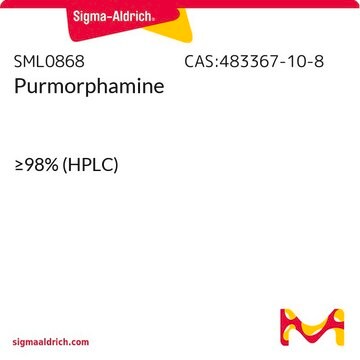540220
Purmorphamine
≥98% (HPLC), solid, Hedgehog signaling activator, Calbiochem
Synonym(s):
Purmorphamine
About This Item
Recommended Products
product name
Purmorphamine, A cell-permeable activator of Hedgehog signaling that induces osteoblast differentiation of multipotent mesenchymal progenitor cells C3H10T1/2 (EC₅₀ = 1 µM).
Assay
≥98% (HPLC)
form
solid
manufacturer/tradename
Calbiochem®
storage condition
OK to freeze
protect from light
color
off-white
solubility
DMSO: 200 mg/mL
shipped in
ambient
storage temp.
2-8°C
InChI
1S/C31H32N6O2/c1-2-9-25(10-3-1)37-21-32-28-29(33-23-13-15-24(16-14-23)36-17-19-38-20-18-36)34-31(35-30(28)37)39-27-12-6-8-22-7-4-5-11-26(22)27/h4-8,11-16,21,25H,1-3,9-10,17-20H2,(H,33,34,35)
InChI key
FYBHCRQFSFYWPY-UHFFFAOYSA-N
General description
Please note that the molecular weight for this compound is batch-specific due to variable water content.
Biochem/physiol Actions
Activation of the Hedgehog signaling pathway
Warning
Reconstitution
Legal Information
Signal Word
Warning
Hazard Statements
Precautionary Statements
Hazard Classifications
Muta. 2
Storage Class Code
11 - Combustible Solids
WGK
WGK 3
Flash Point(F)
Not applicable
Flash Point(C)
Not applicable
Certificates of Analysis (COA)
Search for Certificates of Analysis (COA) by entering the products Lot/Batch Number. Lot and Batch Numbers can be found on a product’s label following the words ‘Lot’ or ‘Batch’.
Already Own This Product?
Find documentation for the products that you have recently purchased in the Document Library.
Customers Also Viewed
Our team of scientists has experience in all areas of research including Life Science, Material Science, Chemical Synthesis, Chromatography, Analytical and many others.
Contact Technical Service














